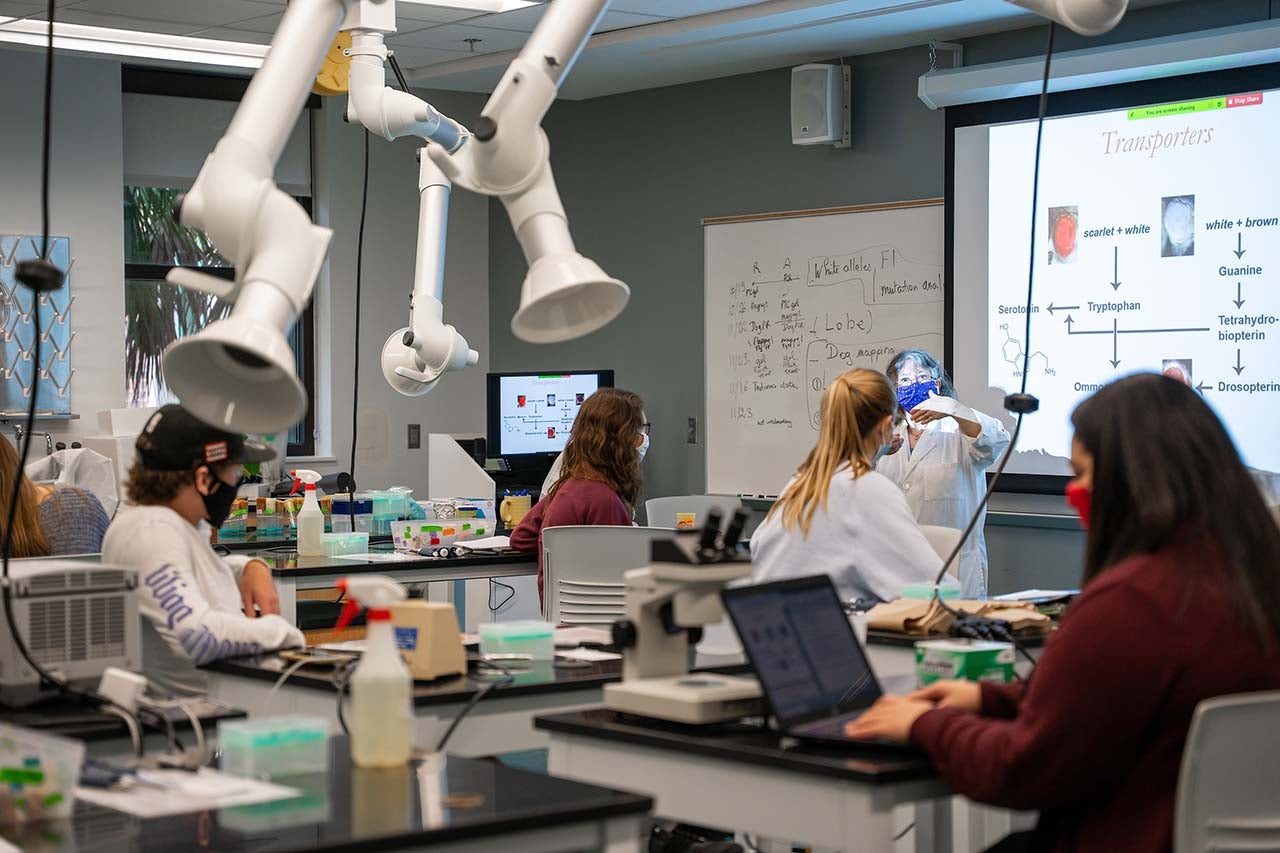Learning Our Way is an occasional series that explores creativity and innovation happening in CofC’s classrooms – whether in person or virtually.
The fall 2020 semester has been one unlike any other in the College of Charleston’s 250-year history. Without question, it’s been challenging for students and professors to forge ahead amid the backdrop of a global pandemic.
But out of the hard times often comes innovation, and that has certainly been the case at CofC, where faculty have expanded the horizons of learning through teaching in a hybrid (online/in-person instruction) format to accommodate reduced classroom occupancy for social distancing.
Whether meeting with students in small groups throughout the school week or simultaneously teaching students in person and online, professors have undoubtedly made the best of an unprecedented situation.
Here’s a look at how some faculty have approached hybrid learning this semester in order to help students thrive.

Students in Erin Leigh’s hybrid course Dance Improvisation and Choreography practice movement patterns while other students participate via Zoom. (Photo by Heather Moran)
Dance Improvisation and Choreography
Teaching a dance class safely in the middle of a pandemic might seem a bit daunting, but Erin Leigh, an adjunct instructor of dance in the College’s Department of Theatre and Dance, has made it work.
With the help of cameras, a television screen and recording equipment, Leigh has been able to teach her course, which meets three days a week, both online via Zoom and in person synchronously, or in real time.
“The class is delivered synchronously, where students create movement studies in response to prompts,” says Leigh, noting that all classes have been recorded so that students can go back and watch should they miss a class. “If a student is participating via Zoom, they can still share their movement ideas and learn from watching their peers.”
Students’ assignments have involved finding or creating video examples of class concepts – and depending on the activity – responding either synchronously during class time or asynchronously by submitting their work.
Experimenting with teaching dance via Zoom this semester has benefited Leigh’s other classes, as well. For example, in Leigh’s Dance Pedagogy and Practice class, assignments requiring students to teach choreography to their fellow classmates both in person and online have given them additional experience with the technology used in delivering the course online as well as with teaching to the camera.
“In some shots we hide non-video participants and have two teachers split the screen so that the in-person dancers can see the front and back sides of the body while learning,” she says. “We have found while using Zoom that some movement is easier to learn with the teacher facing the screen versus facing away, but this is a good compromise of being able to see both.”
Although Leigh has previous experience teaching online courses, teaching dance classes in a hybrid format required a different approach.
“I have taught dance appreciation asynchronously online for several semesters, so – although it wasn’t ideal – I felt comfortable last spring making the leap to teaching all my classes online,” she says. “A choreography class doesn’t translate as easily to asynchronous teaching, but by strategizing different ways to work with Zoom, recording each class and being diligent with communication, I think the students have had a very similar experience to what a fully in-person class would have felt like.”
Spanish 190 and Spanish 200
For Fenner Hoell, adjunct Spanish instructor in the Department of Hispanic Studies, there is no reason for his students to expect anything different regardless of whether they come to class in person or connect via Zoom.
“My students attending via Zoom that day are expected to participate just like my in-person students,” he says.
With classes on Tuesdays and Thursdays, about half of Hoell’s Spanish students attended in person once a week. For each day the students met for class – whether through Zoom or in the classroom – Hoell posted links, documents, worksheets and other content in OAKS, the College’s online learning portal where faculty can post class materials and assignments. To ensure students engage with the day’s lesson, particularly students attending online, Hoell required them to complete a short assignment at the end of the class period.
The key, says Hoell, is to make sure the students are practicing their language skills and mastering the grammar, whether they’re sitting at a desk in front of him or logging in from their residence hall or off campus.
“I break my Zoom participants up into even breakout groups and divide my in-person students into groups as well,” he says. “As everyone is working, I can pop in and out of every breakout room or group to answer questions and make sure everyone is on task.”
And with the integration of technology into the classroom (cameras, microphones, etc.), Hoell says he has been able to seamlessly transition his course into a hybrid format.
“I think the College did a great job installing the necessary hardware in the classroom to facilitate this,” he says. “With the use of the breakout rooms and highlight video features in Zoom, group work, speaking activities and short presentations by my virtual students as well as in-person students are easily completed.”

Students in Chris Korey’s gateway to neuroscience biology class participate in an in-person discussion group following an online meeting of the entire class earlier in the week. (Photo by Heather Moran)
First Year Experience Gateway to Neuroscience
Biology Professor Chris Korey wanted to create a sense of community among the 32 students in his Gateway to Neuroscience biology course, part of a two-course learning community designed specifically for first-year students. But with limited classroom occupancy due to the COVID-19 pandemic, Korey knew he was going to have to approach things differently this fall.
So, he created a format that combined a live online lecture via Zoom with the entire class on Mondays and then small-group instruction in person for half of the students on Wednesdays and the other half on Fridays. On the day they weren’t physically in class, students had reading assignments as well as Korey’s pre-recorded short mini-lectures to review.
“What we learned in the spring is that students appreciate a clear and consistent schedule for their coursework when it is not fully in person all the time,” he says, noting that, with the hybrid format and small in-person groups, he has found it easier to identify material students were struggling with and offer targeted support.
The goal, regardless of whether they were meeting in person or online, has been to create a sense of camaraderie among the students.
“It is super important to connect with students in their first semester on campus and to find ways for them to connect with each other. This has been disrupted significantly by COVID,” says Korey. “However, [first-year] learning communities are specifically designed to foster this community building. My hybrid course design still brought them together in a classroom space so I could facilitate their engagement with some one-on-one interactions. It also helped build community through small-group work in person and in the breakout rooms in Zoom. When they came to class in person, I could clearly see that they had created social communities within my class that are important for their ultimate success at the College.”
Philosophy 120 – Symbolic Logic
For his Symbolic Logic class, Philosophy Professor and Chair Larry Krasnoff has also embraced the small-group approach. With 58 students in two sections of the course, Krasnoff developed online content and assignments for students to complete on their own time and then held six weekly discussions in smaller groups, four in person and two on Zoom.
“I think the in-person discussions with just eight to 10 people are really great,” says Krasnoff. “It’s much easier to see what people are understanding and for us to do problems together, with different students suggesting different steps.”
And the silver lining, says Krasnoff, is that his students seem to better understand the importance of completing homework and projects asynchronously (on their own time, outside of a scheduled class setting) in order to get the most out of the class.
“Symbolic logic is a kind of math class, so there are always problems to practice with. I’ve always required homework, but with limited class meetings, it is now much more clear to students why they have to do it,” he says. “Logic is a skill-based course, and having the class partially asynchronous drives home the message that students need to master the skills on their own. They can’t just come to class and absorb them by watching. That was always true, but I think more students understand it this semester.”

Students attend BIOL 305L – Genetics Lab, taught by Agnes Ayme-Southgate in the Rita Hollings Science Center. Students attended the lab in-person as well as virtually. (Photos by Mike Ledford)
Biology-305L – Genetics Lab
A science lab seems like it would be nearly impossible to teach in a hybrid format, but biology Professor Agnes Ayme-Southgate has managed to pulled it off.
Making use of both Zoom and OAKS, Ayme-Southgate has found innovative ways to teach students both face to face and entirely online. She has even taken advantage of the cameras and microphones installed in the labs to teach in person and online at the same time.
“I implemented many exercises that could be done on either format, and I made use of breakout rooms on Zoom to facilitate student teamwork,” she says, noting that one of her labs had nine students attending in-person and six online and that the other had eight in-person students and six online.
Although not all experiments can be replicated outside of the lab, students taking the course online have been able to practice scientific analysis via online assignments evaluating data sets from previous experiments.
Thanks to the prevalence of digitized scientific data and samples, however, Ayme-Southgate has been able to preserve much of the lab work for students online and engage them alongside their peers in the classroom.
“For activities that require being in the lab, I created alternative, equivalent assignments,” she says. “For example, rather than students doing observations under microscopes, I created a collection of microscope images that I posted on OAKS for students to observe and work on, so they were still able to get a laboratory experience.”




